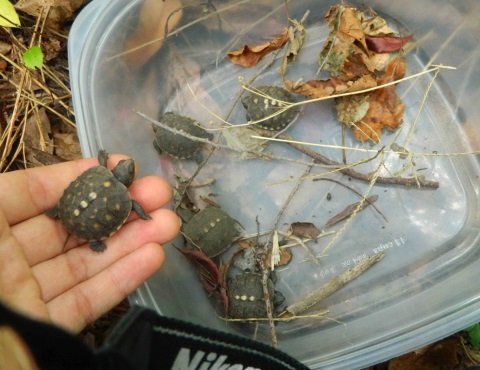What are the Predators of Box Turtles?
Curious about the predators of box turtles? Well, you’ve come to the right place! Box turtles, those fascinating creatures that roam the woodlands and grasslands, face a variety of threats from opportunistic predators.
These shy reptiles may seem well-protected within their sturdy shells, but there are cunning predators that have mastered the art of cracking their defenses. From stealthy foxes to agile raccoons, the natural world harbors a diverse range of creatures that view box turtles as a delectable meal.
Today, we’ll delve into the perilous world of box turtle predators and explore the challenges these resilient creatures face to survive in the wild. So, let’s begin our exploration and uncover the secrets behind the question: What are the predators of box turtles?
What are the Predators of Box Turtles?
Box turtles, with their unique appearance and fascinating behaviors, are popular among reptile enthusiasts. These small to medium-sized land turtles can be found in a variety of habitats throughout North America. However, despite their relative adaptability, box turtles face a range of predators that pose a threat to their survival. In this article, we will explore the various predators that target box turtles and discuss the strategies these resilient reptiles employ to defend themselves.
1. Natural Predators
In their natural habitats, box turtles encounter numerous predators that have evolved to exploit their vulnerabilities. These predators, both terrestrial and aerial, include:
Terrrestrial Predators
- Raccoons – Raccoons are opportunistic feeders and are known to consume box turtles if given the chance.
- Skunks – Skunks have been observed preying on box turtles, especially during encounters in or near water sources.
- Opossums – Opossums are omnivorous creatures and may occasionally prey on box turtles.
- Snakes – Various snake species, such as rat snakes and kingsnakes, have been documented preying on box turtles.
- Small Mammals – Animals like rats, mice, and even domestic cats can pose a threat to box turtles, particularly hatchlings and juveniles.
Aerial Predators
- Raptors – Birds of prey, such as hawks and owls, are capable of capturing and consuming box turtles.
2. Introduced Predators
Unfortunately, box turtles not only have to contend with their natural predators but also face additional threats from introduced species that have been introduced to their habitats. Some of these introduced predators include:
Red-Eared Sliders
- Red-eared sliders are highly adaptable aquatic turtles that often compete with box turtles for resources and prey on their eggs and hatchlings.
Domestic Pets
- Unrestrained dogs and cats can adversely impact box turtle populations, especially in urban or suburban areas.
3. Strategies of Defense
To survive in the face of these predators, box turtles have evolved several defense mechanisms and strategies:
Shell Protection
- Box turtles possess a unique ability to close their plastron (bottom shell) tightly against their carapace (top shell), providing effective protection from predators.
- By withdrawing their head and legs into the shell, box turtles create a secure fortress that is difficult for most predators to breach.
Camouflage
- Box turtles have remarkable camouflage that helps them blend into their environment, making it harder for predators to locate them.
- Their domed, high-ridged shells are often covered with moss, leaf litter, or other debris, further enhancing their camouflage.
Behavioral Adaptations
- When threatened, box turtles can retract their limbs and head into their shells, remaining motionless until the danger passes.
- Some box turtles may release a foul-smelling musk or excrete urine, which can deter predators.
Hiding and Burrowing
- Box turtles are skilled diggers and will take refuge in burrows or hide under vegetation to avoid detection by predators.
- They can also dig shallow depressions to bury themselves partially, camouflaging their presence and reducing their chances of being spotted.
Speed and Agility
- Although not known for their speed, box turtles can move surprisingly quickly when they sense danger, employing rapid bursts of energy to escape from predators.
4. Human Impact
While box turtles have evolved to deal with natural predators, they face an increasing threat from human activities. Habitat loss, fragmentation, pollution, and the illegal pet trade all contribute to the decline of box turtle populations.
5. Conservation Efforts
To protect box turtles and their habitats, various conservation initiatives have been established. These efforts focus on habitat preservation, population monitoring, and raising awareness about the importance of conserving these unique creatures.
FAQs
Q: Are box turtles at risk of predation throughout their lives?
A: While box turtles face predation threats throughout their lives, they are most vulnerable in their early stages when they are hatchlings or juveniles.
Q: Can box turtles defend themselves against their predators?
A: Yes, box turtles have several defense mechanisms to protect themselves from predators, including retreating into their shells and employing camouflage to blend into their surroundings.
Q: Can box turtles bite their predators?
A: While box turtles possess a beak-like jaw, they mainly rely on their defense mechanisms and strategies rather than aggressive biting to deter predators.
Frequently Asked Questions
What are the predators of box turtles?
Box turtles, both young and mature, are vulnerable to several predators in their natural habitat. Here are some common predators of box turtles:
1. What animals prey on box turtles?
Box turtles are often preyed upon by a variety of predators, including raccoons, skunks, foxes, snakes, dogs, and cats.
2. Do birds of prey feed on box turtles?
Yes, certain birds of prey such as hawks and owls are known to hunt box turtles, especially the smaller and more vulnerable individuals.
3. Are there any aquatic predators that target box turtles?
Yes, some aquatic predators like large fish, snapping turtles, and water snakes pose a threat to box turtles, especially when they venture near water bodies.
4. Do mammals pose a significant threat to box turtles?
Yes, mammals such as foxes, raccoons, and skunks are opportunistic predators and may actively seek out box turtles as a source of food.
5. Are box turtle eggs also targeted by predators?
Yes, box turtle nests and the eggs within them are often raided by small mammals like raccoons and skunks, as well as larger predators like coyotes and bears.
6. Do humans pose a threat to box turtles?
While not natural predators, human activities such as habitat destruction, road accidents, and the illegal pet trade can be detrimental to box turtle populations.
7. Are there any defensive mechanisms that box turtles use against predators?
Box turtles have several defense mechanisms to protect them from predators, including their ability to retract their head, limbs, and tail into their shell, as well as their sharp beak and strong jaws used for biting.
Final Thoughts
Box turtles face a variety of predators in their natural habitats. These include raccoons, skunks, foxes, and certain bird species such as crows and ravens. These predators are well adapted to locate and capture box turtles, which can have significant impacts on their population numbers. However, box turtles have evolved several defense mechanisms such as their protective shell and ability to retreat into it, allowing them to escape some predation attempts. Despite these adaptations, the presence of predators remains a constant threat to box turtles’ survival in the wild. Understanding and mitigating the impacts of these predators is crucial for the conservation and protection of box turtles in their ecosystems. So, what are the predators of box turtles?

